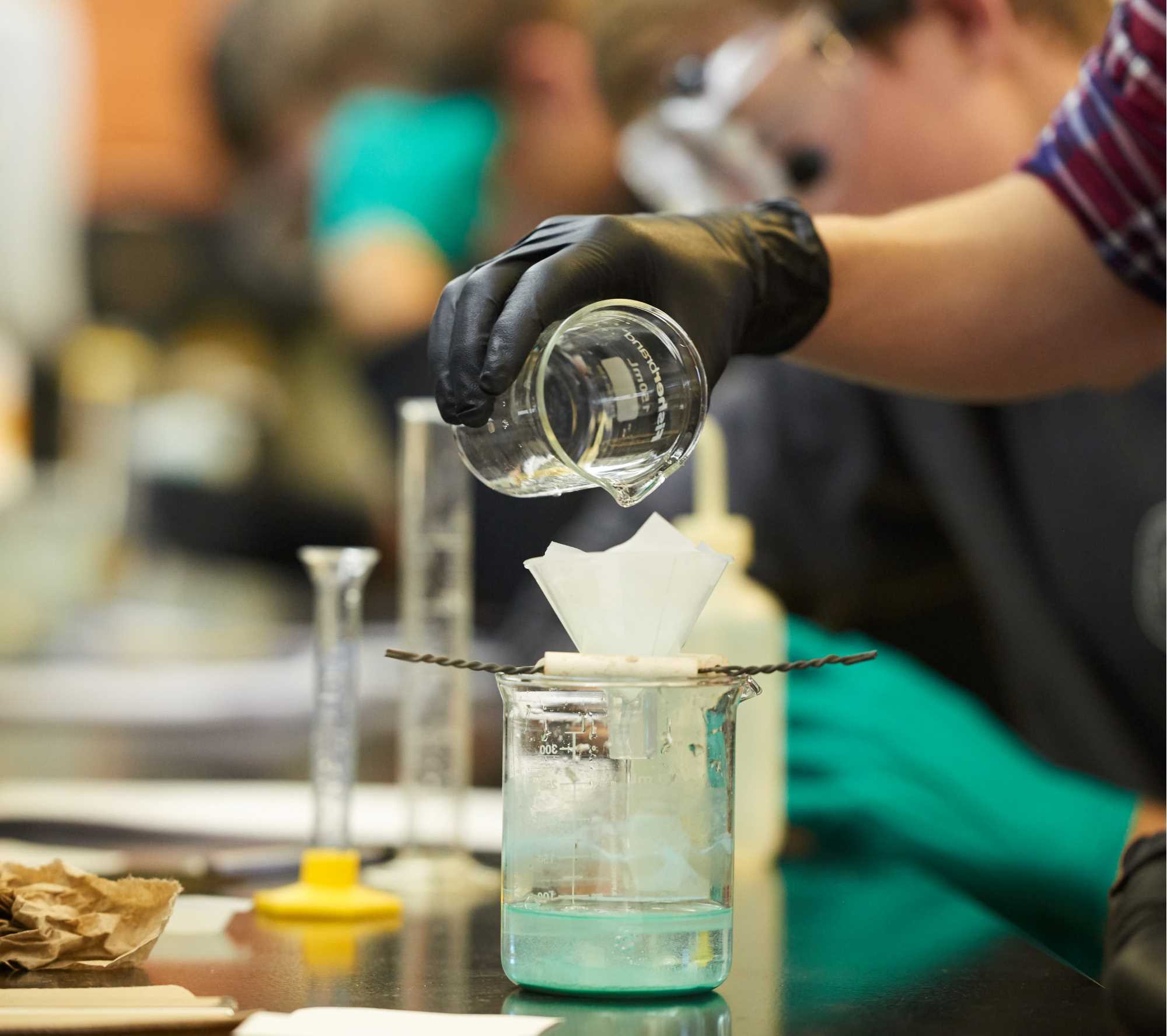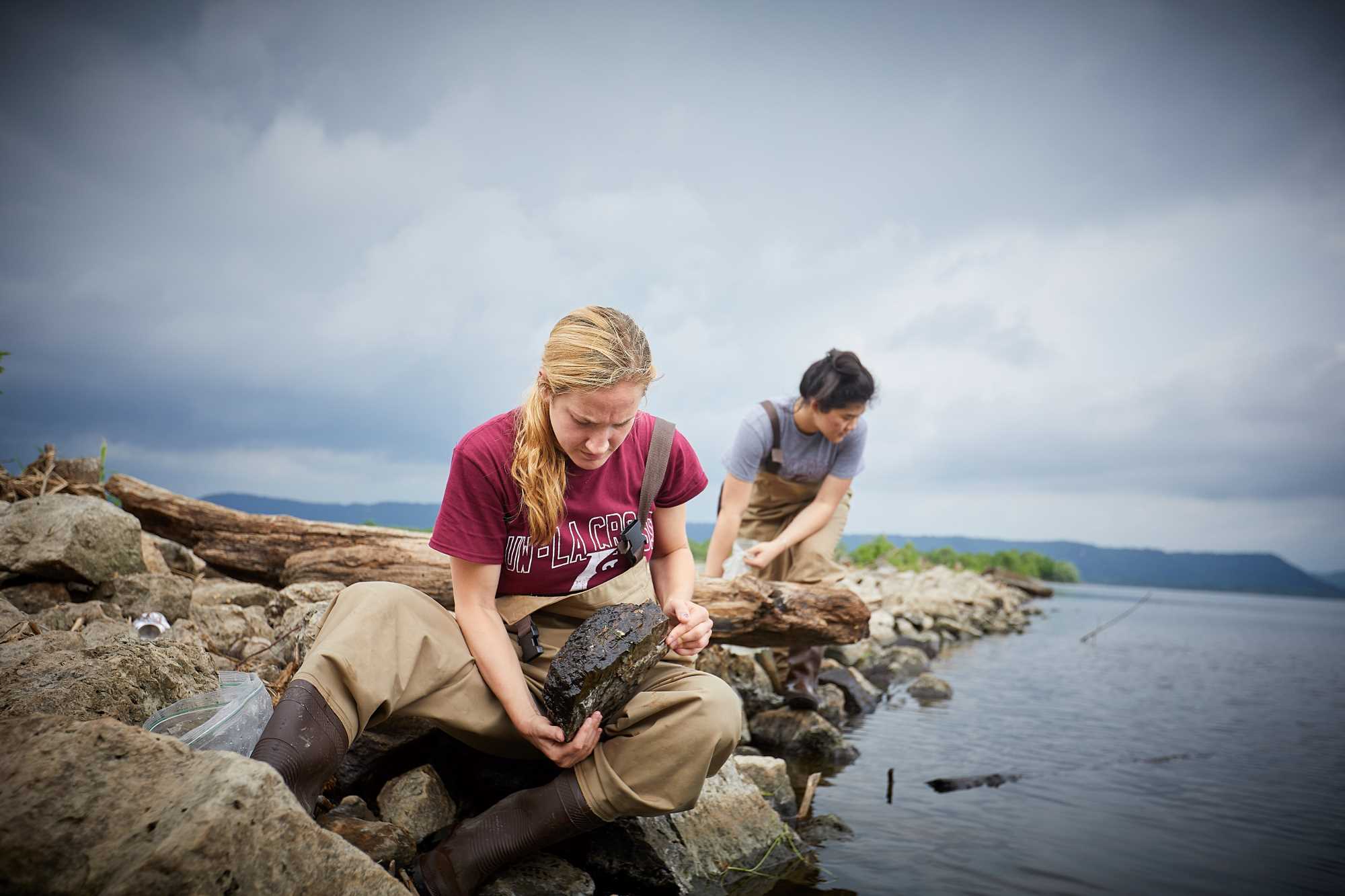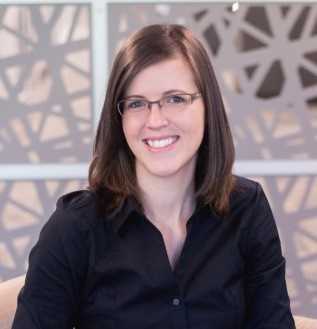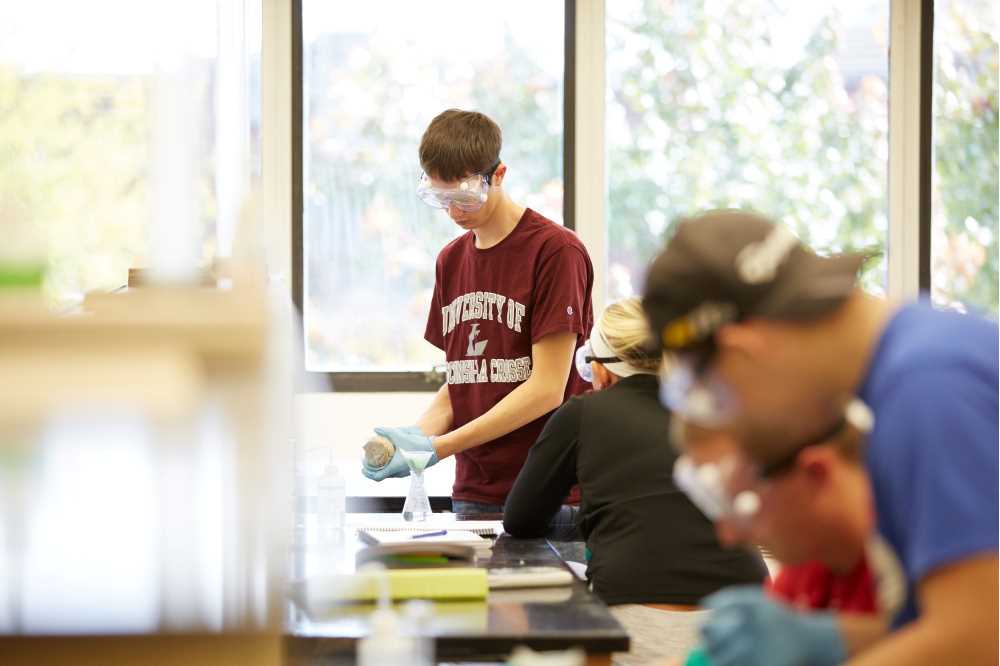Chemistry program
Explore the science that powers innovation.
Whether it's developing new medications, monitoring environmental pollutants, or advancing sustainable energy solutions, chemistry is at the heart of solving real-world challenges.
At UW-La Crosse, a chemistry education provides a strong foundation for a wide range of career paths. Our program combines hands-on research with modern equipment and a focus on practical skill development. Students gain experience designing experiments, analyzing data and communicating scientific results — all while building essential workplace skills like teamwork, problem solving, and effective communication.
The UWL Department of Chemistry and Biochemistry is accredited by both the American Chemical Society-Committee on Professional Training (ACS-CPT) and the American Society for Biochemistry and Molecular Biology (ASBMB).
Chemistry
Chemistry is the study of substances, their properties, energies, the ways they interact and combine and change. Traditionally, chemistry has been broken into five main sub-disciplines: Organic, Analytical, Physical, Inorganic, and Biochemistry. The field also includes a variety of applied disciplines. Chemistry is often referred to as the central science because it joins together physics and mathematics, biology and medicine, and the earth and environmental sciences.
Undergrad major Undergrad minor View a sample plan for Chemistry Catalogfor Chemistry Learn more for ChemistryACS Certification
UWL's Chemistry program is approved by the American Chemical Society (ACS). This degree track includes the coursework and experiences necessary to satisfy the requirements for ACS certification, meaning students who meet the ACS guidelines will receive an ACS-Certified Bachelor of Science degree in chemistry.
Undergrad major View a sample plan for ACS Certification Catalogfor ACS CertificationBusiness Concentration
The chemistry major with a business concentration is appealing to students interested in both the science and business sides of chemistry. Students learn core chemical theory and laboratory skills through a series of chemistry courses. They also gain a strong foundation in business through courses in management, accounting, finance, and marketing.
Undergrad major View a sample plan for Business Catalogfor BusinessScience Education
The Chemistry Education Program includes the coursework and classroom experiences necessary to satisfy the requirements for a science, grades 4-12 (2600) teaching license in the state of Wisconsin.
Undergrad major Teacher license View a sample plan for Science Education Catalogfor Science EducationEnvironmental Science Concentration
The chemistry major with an environmental science concentration provides a strong background in chemistry, along with multi-disciplinary, elective course options to explore areas such as climate change, contaminants, renewable energy, geospatial analysis, and ecosystem modeling.
Undergrad major View a sample plan for Environmental Science Catalogfor Environmental ScienceUndergrad dual degree
Chemistry majors with interest in engineering may be able to receive both a UWL bachelor’s degree in chemistry and a bachelor’s degree in engineering from UW-Madison. At UWL, students must complete a minimum of 87 credits, including the general education requirements and specific math and science courses in preparation for the engineering program.
Undergrad major View a sample plan for Undergrad dual degree Catalogfor Undergrad dual degreeWhat can you do with a chemistry degree?
Career possibilities in chemistry are wide ranging. Explore careers in chemistry on the American Chemical Society (ACS) College to Career page. Positions are available in industry, research, education, engineering, health professions, public service and more. Even in times when unemployment rates are high, the chemist remains one of the most highly sought after and employed scientists. The median pay of chemists and materials scientists in 2024 was $86,620 per year, according to the Bureau of Labor Statistics.
Careers examples
- Research chemist, Centers for Disease Control
- Government scientist, Department of Agriculture
- Industrial chemist, managing pollution control
- Science policy advocate, non-profit
- Chemistry professor (with further education)
- H.S. science teacher (with teacher certification)
Further education
- Medical or other professional study in pharmacy, veterinary medicine, nuclear medicine, optometry, dentistry and more
- Graduate study in analytical chemistry, biochemistry, organic chemistry, inorganic chemistry, physical chemistry, material science, polymer chemistry, chemical engineering and more
- Law school (example: patent law)
- Industrial management training
- Graduate study in business
What distinguishes UWL's chemistry program?
The Department of Chemistry and Biochemistry is able to award more than $30,000 in student scholarships annually to support returning undergraduate students in the major and graduates of the program who are entering a professional program in the basic sciences and/or health professions. Learn more about Chemistry scholarship opportunities.
Students have numerous opportunities to get involved in cutting-edge chemical, biochemical, and educational undergraduate research projects. In 2019-20, the Chemistry Department had the highest percentage of students participating in undergraduate research at UWL. Learn about the research interests of faculty.
Students will gain experience using high-end scientific instrumentation. This instrumentation includes: Imaging and Surface Analysis, Spectroscopy, Electrochemical and Electrical, Separations, Thermal Methods, X-ray, NMR, Radiation, Sample Preparation.
Students are given broad preparation with both technical and soft skills. This leads to graduates who are flexible and creative problem solvers who can adapt and thrive as their career advances.
The chemistry program is approved by the American Chemical Society (ACS) and offers a prestigious ACS-Certified bachelor's degree in chemistry for students who meet the required guidelines. The chemistry program offers several other bachelor’s degree and minor options. See the catalog for more information.
Faculty represent all of the major sub-fields of chemistry and have a diverse range of research interests. Areas of expertise within chemistry include: organic, inorganic, nuclear, physical, forensic, atmospheric, environmental, computational, analytical, medicinal, biochemistry and more.
Faculty in the department generously give their time to assist students with coursework, and college and career advising. Students have opportunities to connect and enjoy fund and informative experiences through the Chemistry and Biochemistry Club.
Students are encouraged to participate in internship experiences, which may be taken for academic credit. They offer practical experiences in the field, and, in some cases, are paid. Campus support is available to help find internships through UWL Career Services and Handshake.
The Chemistry & Biochemistry Department currently has over 250 student majors. Each year, over 30 students graduate with bachelor of science degrees in chemistry or biochemistry. Typically, 30-50% of graduating seniors apply to, and are accepted by graduate programs at major research universities where they pursue doctoral degrees in chemistry or related areas.
The Chemistry Department had 223 total majors in fall of 2022 with 42% of those majors indicating they are on the pre-health track, looking to future careers in healthcare fields.
Students routinely co-author professional presentations and publications with chemistry faculty members. Students often present their research at regional and national meetings. Examples of co-authored research include:
- Roskam JL, Nowak KL, Taylor KT, Rendler SR, and Beyer KD. (2021) Phase diagrams of aqueous solutions of the potassium salts of malonic, succinic, and glutaric acids. The Journal of Chemical Thermodynamics. 158: 106466-106477.
- Stuttgen GM, Grosskopf JD, Berger CR, May JF, Bhattacharyya B, and Weaver TM. (2020) Closed fumarase C active-site structures reveal SS Loop residue contribution in catalysis. FEBS Letters. 594(2); 337-357.
- Thielen MK, Vaneerd CK, Goswami M, Carlson EE, and May JF. (2020) 2-aminobenzothiazoles inhibit virulence gene expression and block polymyxin resistance in Salmonella enterica. ChemBioChem. 21(24): 3500-3503.
- Macedo LJA, Miller EN, and Opdahl A. (2017) Effect of probe-probe distance on the stability of DNA hybrids on surfaces. Analytical Chemistry. 89(3): 1757-1763.
















